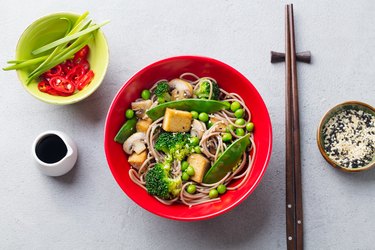
Just when you've mastered healthy eating at home, tackling unfamiliar cuisines, such as sushi or hibachi restaurants, becomes a new issue when dining out. But nutritious, low-calorie Japanese food isn't hard to find, with a bit of planning.
Avoid the Pitfalls
Video of the Day
There are a few handy phrases and ingredients to be on the lookout for when you're trying to enjoy heart-healthy and low-calorie Japanese food. Indulging in too many of these can spell trouble for your health goals:
Video of the Day
- Soy sauce: Even "low sodium" soy sauce has about 500 milligrams of sodium per tablespoon, with regular soy sauce having about 900 milligrams, according to the USDA.
- Tempura: The Mayo Clinic warns against this type of preparation. Tempura calls for breading and deep-frying, adding fat and empty carbs to your meal. Avoid foods described as "crispy," unless the menu specifies an oven-baked preparation.
- Agemono: Meaning "deep-fried," the term "agemono" can appear on a menu, along with the related "tempura." According to Mayo Clinic, dishes like shrimp agemono are among the least-healthy Japanese restaurant menu options.
- Creamy condiments and fillings: Dipping sauces are tempting for your sushi rolls and cooked tidbits. Cleveland Clinic points out that most are mayonnaise-based, presenting yet another opportunity to pile on saturated fat. In addition, the Western-style "Philadelphia roll" is a sushi-like concoction that's heavy on cream cheese
- Imitation crab: Yes, there's a bit of "seafood" in imitation crab, but also unhealthy fillers that are high in sugar and sodium.
- Chicken katsu: The Mayo Clinic lists this meal as a definite "must miss" when seeking health Japanese restaurant options. Chicken katsu is analogous to American fast-food chicken tenders, given the breaded and fried preparation, and sugary sauces.
- Fried entrees: For obvious reasons, menu items like "fried pork" or "fried tofu" should be avoided.
Order Satisfying Starters and Sides
Quell your raging appetite at the outset of a meal with healthy dishes. Picking healthy sides will also keep you from over-indulging.
Low-calorie Japanese food options for appetizers include clear soup and salad. Green salads have special touches, like sliced ginger, to keep things interesting, or you can get adventurous with a nutrient-packed seaweed salad.
Miso soup, which combines broth with tofu, and which is flavored with bean paste, is a calorie-light choice. Sui-mono is another delicate, broth-based soup which is less salty than miso soup. In addition, look for edamame (crunchy soybeans) or steamed spinach from the appetizer or side dish menus.
The Mayo Clinic suggests vegetable and rice, also known as kayaku gohan, as a healthy side dish or entree. Udon or soba noodles are fiber-rich side dishes. Of course, you can also order a green or seaweed salad with your entree, instead of having it as an appetizer.
Read more: Is Ramen a Good Diet Food?
Healthy Japanese Restaurant Entrees
Many Japanese menus offer a wealth of main course options, from various sushi rolls to specialty "bowls." This allows you to pick dishes featuring the healthiest versions of classic Japanese ingredients.
Whenever possible, choose sushi and other entrees with brown rice, which is higher in fiber and minerals than white sushi rice. If you're trying to limit carbohydrates altogether, look for sushi rolls with no rice as either filler or as wrappings. Seaweed or sliced cucumber strips also make handy wrappings.
Some of the most well-known staple Japanese ingredients are also the healthiest, especially if the dish relies on them instead of other fillers. Fresh tuna and salmon are good sources of Omega-3 fats, while diced avocado offers another healthy fat option.
Often, the same dish is offered with different cooking methods, which greatly influences how healthy it ends up. The Mayo Clinic notes that steamed dumplings are better choices than their fried counterparts, and teriyaki chicken and other proteins are also preferable to deep-fried proteins.
If you're watching calories in Japanese food hibachi, choose lower-fat proteins like seafood and chicken over pork and beef, and load as much of your plate as possible with the vegetables the chef flips your way.